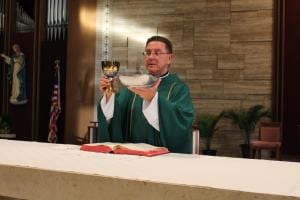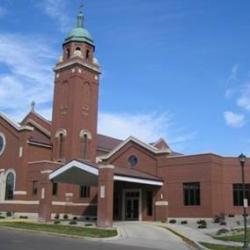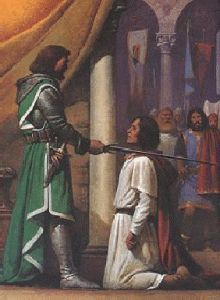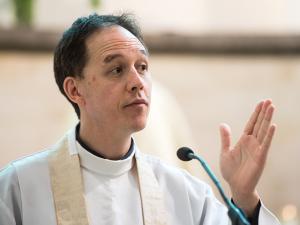
In recent years I have seen some priests taking a step backwards to my childhood at the Consecration of the Mass. There’s a prolonged pause as the priest raises the host or the chalice as high as he can. I recall such a ritual from the old Latin Mass, but I’ve grown accustomed to a shorter, less exalted and less dramatic Consecration. Is that step back for better or worse or neither? Thinking about backwards and forwards is no way to get an answer. The answer depends on the Consecration itself and its place in the sacrifice of the Mass.
To eliminate suspense, I’ll put the answer up front. Here it is from the General Instruction of the Roman Missal:
150. A little before the Consecration, if appropriate, a minister rings a small bell as a signal to the faithful. The minister also rings the small bell at each elevation by the Priest, according to local custom. If incense is being used, when the host and the chalice are shown to the people after the Consecration, a minister incenses them. (emphasis added)
Alright, the GIRM gives two answers (see bold print). I really want to whittle it down to one. There are two ways of looking at the combination of elevating and showing:
- When you elevate something, you are also, incidentally, showing it. The emphasis is on the elevating the Sacrament. To do that well, you probably would raise it high and long.
- In order to show something, you have to elevate it. Now the emphasis is on the showing, and a moderating amount of raising makes for a perfectly good showing.
My preference is for the second interpretation although the text supports either one. I do not think raising the Sacrament high, the first interpretation, is appropriate for this part of the Mass. Neither is the elevation a good time for a long pause. Fr. Anthony Ruff, O.S.B., at the Pray Tell blog and the folks at epicPew will help me make this point.
Ocular Communion
The Consecration is an extraordinary moment, the moment when bread and wine become the body, blood, soul, and divinity of Jesus Christ. I can see why a priest would want to hold on to this moment—to honor, and adore Jesus and to give the congregation time to see, honor, and adore.
Actually, this practice, which above I called a “step back,” goes back further than my childhood. In a Medieval Cathedral some 800 years ago, a priest was saying Mass and had gotten to the Consecration. The congregation was huge. Very few of the people would receive Communion that day. An Augustinian sense of unworthiness kept them away. The Fourth Lateran Council had to make a new law: People must receive communion at least once a year. In my (earlier) days, Catholic children memorized, along with the Ten Commandments, the six Precepts of the Church, of which this is one. It’s an anachronism today, but still on the books.
But back to that Middle Ages Mass. Without the physical touch of the Body of Christ in Communion, hearing none of the priest’s words whispered in Latin, and seeing almost nothing except the priest’s back toward the congregation, one eager worshiper in the back shouted, as the bell for the Elevation rang, “Sir Priest, heave it higher!” That would be his Communion for that Sunday. EpicPer relates that somebody had invented a name for it — “Ocular Communion.”
The mystical power that a former age attributed to the sense of sight is foreign to us, who know how the eye works. Still I can imagine something like Ocular Communion and adoration of Jesus really present going on as the priest raises high the Blessed Sacrament and holds it there. Is that wrong?
Honoring the Father
My answer is that it’s not the best. Consider what Jesus’ purpose in the Eucharistic Prayer is. This prayer is not to honor Jesus. The whole prayer is Jesus’ sacrifice of praise to the Father. Raising the Bread and Cup as high as possible might symbolize Jesus offering himself to the Father, but the words of Consecration don’t mention the Father. They do mention an offering, but it’s not to the Father:
This is my body, which will be given up for you…. This is the chalice of my blood…which will be poured out for you and for many.
The Great offering to God the Father takes place later, at the end of the Eucharistic Prayer:
Through him, and with him, and in him, O God Almighty Father, in the unity of the Holy Spirit, all glory and honor is yours, forever and ever.
This “doxology” (praise words) is the time for a prolonged gesture of elevating the host and cup. It lasts through the recitation or singing of this praise offering and the people’s Amen. The priest holds up the Eucharistic elements, but it’s not these elements but praise that is going “up” to the Father. The elevation doesn’t have to be especially high, but it is dramatic, especially when priest, and not just choir and assembly, sings.
Fr. Ruff on Popular, traditionalist, and third ways
Liturgist Anthony Ruff, on this Pray/Tell blog entry finds three styles of priest leadership at the Consecration. He calls them popular, traditionalist, and third way and demonstrates them with videos.
The well-intentioned populist:
The Well-Intentioned Populist eyeballs the congregation. But the Eucharistic Prayer, though it certainly involves the congregation through their baptism into Christ’s priesthood, is not addressed to the congregation, it is addressed to the Father. To act out the Institution Narrative – “I’ll be Jesus and you all be the disciples” – is to misunderstand this prayer. The priest’s role is to draw the people into his (and ultimately, Jesus’) offering to the Father. The people are not addressees, they are co-actors.
This demonstration included a common practice which I rather liked — until now. As the priest says the words of institution, he slowly rotates the sacred element side to side in a large arc, as if presenting it to every one of the assembled worshipers. As Rupp says, we’re not the disciples at this point.
The holier-than-thou traditionalist
The Holier-Than-Thou Traditionalist … wants the liturgy to be more reverent and serious, which is laudable. But he’s finding his solution in the wrong places. By using a markedly different tone of voice, he rips the Institution Narrative from its larger context and gives the impression that only the magic words (‘hocus pocus’) matter. By staring only at the host, as if to shut out everyone and everything around him, he gives the impression that Christ’s presence is localized there and does not involve the rest of the congregation (not to say all of redeemed creation).
“Holier-than-thou” might be an unfair characterization of the priest, but the prolonged elevation that follows the words of institution is a priest’s personal piety rather than the liturgical rule. As an older Catholic, I remember the intense concentration on the words of institution that was the common practice in the pre-Vatican II Mass. Each word had to be pronounced whole and by itself: “Hoc … est … enim … corpus … meum.” Recently I saw a priest do the same thing in English.
The third way
There is a better way … which the reformed liturgical books allow and suggest. The priest ‘bows slightly,’ as the Missal states, with humble (i.e. understated) reverence. The rubric preserves the objectivity and directionality of this action, without furthering the worst of medieval sacramental misunderstandings which the reforms sought to correct. The showing of the host does not treat it as an isolated relic, but as a strong sign of Christ’s presence among his people. The priest’s manner neither manipulates nor ignores the people.
One of those”medieval sacramental misunderstandings” is to isolate the presence of Jesus in the sacrament from the movement of the Eucharistic Prayer and the whole Mass. The purpose of the Mass is not to contemplate Jesus but to participate in his work. The Consecration is not a climax but an important step on the way to Jesus’ Great Offering of praise to the Father at the Doxology. And that is a step on the way to the climax of the Mass–the Communion.
A liturgical wish: May the form of the liturgy always move the People of God toward active participation in Jesus’ work of bringing creation’s prayer of praise to the seat of God the Father.
Image credit: pxhere.com via Google Images












